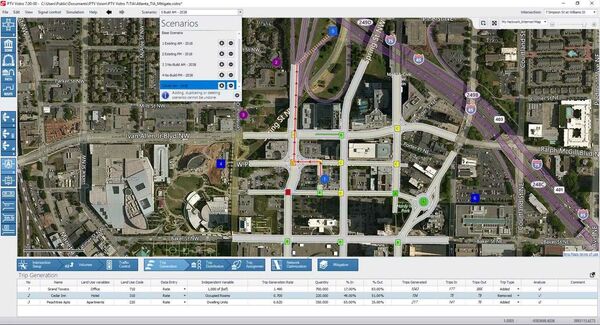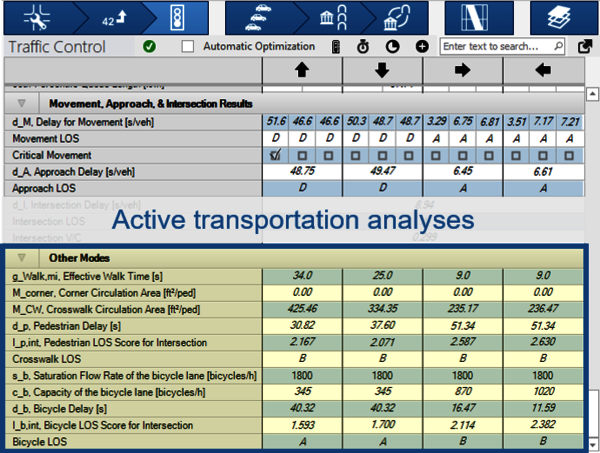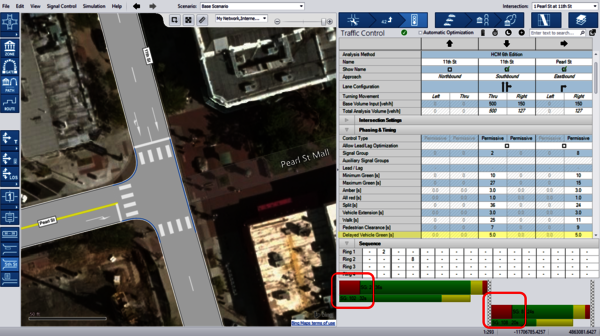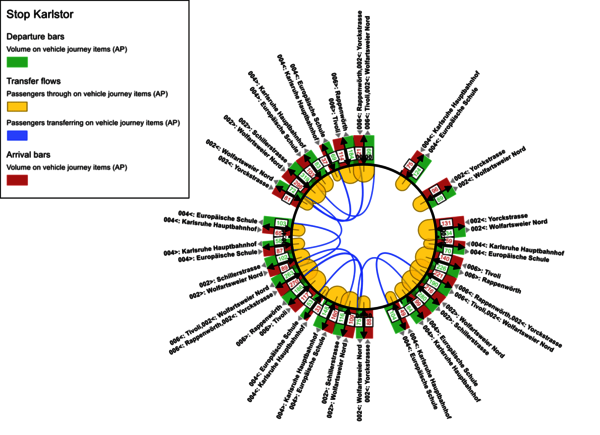Transit planning tool for operations screening
Today’s city requires a sophisticated toolkit to analyze the multiple layers of urban mobility near transit hubs and bus stops. Engineering and planning teams work closely together studying the impacts of emerging transit-oriented developments. Moreover, these teams optimize concepts and safe designs of first- and last-mile connections. In addition, these tasks require quick, efficient, and cost-effective deterministic transit planning tool sets. These tools process and document countless scenarios and iterations. To answer the call, PTV Vistro includes robust traffic signal operations analyses. Also, Vistro incorporates active transportation features and operational transit planning tool functionality.
Evaluating bus stop impacts at intersection traffic operations
Do you have a new bus rapid transit line or need to systematically reevaluate your bus stop locations? PTV Vistro provides you with transit planning tool functionality that uses industry-standard methods. Conducting this stop location screening requires a minimum set of data and model inputs for quick testing.
Graphically displayed measures-of-effectiveness (MOE) like delays volume-to-capacity ratios, and queue lengths colorfully illustrate the direct impact of bus stops at signalized intersections. Furthermore, PTV Vistro’s scenario and mitigation managers and reporting provide a clean workflow to test and document these findings. After preferred stop locations are determined in PTV Vistro, you can continue detailed analysis with PTV Vissim and PTV Visum.

PTV Vistro has a intuitive scenario management organizing existing, horizon-year, build-year scenarios, mitigation studies, alternatives, or countermeasure analyses used to for traffic signal optimization or a traffic impact analysis study.
Screening intersections for bus stops.
PTV Vistro utilizes traffic signal analysis methods from the Highway Capacity Manual (HCM) 6th Edition. First, this procedure allows you to enter a Local Bus Stopping Rate (buses per hour). This calculates operational impacts from a movement group’s blocked traffic flow. Also, this calculation is not dependent on the details of near- and far-side stop configurations. Rather, this calculation provides a high-level screening option to evaluate overall intersection operations with bus stops.
Determining transit stop near- and far-side configurations with the Canadian Capacity Guide
Inclusion of the Canadian Capacity Guide increases PTV Vistro’s deterministic public transit planning tool capabilities. Near- and far-side stop configurations influence operations at signalized intersections and are greatly influenced by local conditions. Additionally, to understand these site-specific impacts, the CCG provides additional parameters and calculations.
Both far- and near-side stop locations use lane utilizations, average boarding and alighting rates, and dwell times. These parameters estimate blockage times. Furthermore, near-side stop analyses utilize a ‘percent loading on green’ parameter to address reductions in effective green times. However, far-side stop analyses consider the limited storage or discharge space between the intersection and stop location. In addition, the CCG restricts this space only when a bus or a streetcar is present.

PTV Vistro's deterministic public transit planning capabilities are increased with the inclusion of the Canadian Capacity Guide.
Transit planning tool estimations for bus and rail
Building advanced traffic signal controllers in PTV Vistro is intuitive with the Additional Signal Groups window and customizable Sequence Diagram. Moreover, utilizing this flexible setup is instrumental in a transit planning tool to estimate the impacts of transit operations.
Estimating passive transit-signal priority (TSP)
Intersection locations with tight headways or overlapping routes may experience detected transit vehicle calls on nearly every signal cycle length. Therefore, at these locations, fixed-time transit phases, or Passive TSP, provide a quick estimate to analyze public transportation impacts. Passive TSP executes continuously, even without the presence of transit vehicles. The following tutorial illustrates passive TSP setup:
Approximating active TSP with queue jump lanes
Transit queue-jumps utilize short dedicated lanes. In these lanes, transit vehicles move to a priority position and bypass queued vehicles on the approach. Once in position, detection places a priority call to the transit signal group. Estimating active TSP in Vistro provides a general understanding of queue jump operations. This begins by adding a special transit leg to access traffic volumes and detection parameters.
Furthermore, importing PTV Vistro into PTV Vissim or PTV Visum migrates your special transit leg, detection, and signal groups into an advanced transit planning tool. These advanced transit planning tool sets include TSP elements, such as phase omits, minor street truncations, and signal corridor coordination. The following tutorial shows how to create active TSP in PTV Vistro, building from the passive TSP example:
Creating Parallel facilities for transit and cycle tracks
PTV Vistro’s flexible geometry enables the creation of parallel facilities. These separated lanes represent dedicated transit and bicycle lanes. A parallel facility allows you to view a time-space diagram with custom speeds and clearance intervals. This is extremely useful when understanding green waves of cycle tracks. In addition, a parallel facility allows green wave visualization of queue jump lanes with adjacent intersections. Also, these facilities will import into PTV Vissim for further analysis. The following tutorial describes how to create a parallel facility:
Active transportation planning use cases
Transit facilities must include safe crossings and connections for active transportation modes. The study of these interactions requires a comprehensive transit planning tool. PTV Vistro provides a full multimodal experience to complement transit planning. For example, near- or far-side transit stop placement should also take into consideration pedestrian impacts at an intersection.
Bicycle and pedestrian analysis
The HCM 6th Edition methods evaluate your solution’s multimodal deficiencies and effectiveness. Pedestrian outputs evaluate signalized intersection crossing elements, such as corner circulation measurements, delay, LOS score, and crosswalk LOS. Also, Vistro reports the effectiveness of bicycles traveling through the intersection.

Active transportation analysis measures of effectiveness from the Highway Capacity Manual 6th Edition are viewed in the Traffic Control workflow.
Leading pedestrian intervals and exclusive pedestrian phases.
Solutions like leading pedestrian intervals (LPIs) at traffic signals are wide-spread active transportation plan features. This feature requires no additional signal phases to fool the software; thus, you are modeling exact LPI operations. With PTV Vistro’s built-in Delayed Vehicle Green input, red time is inserted at the start of the signal group split. This delays the vehicular start of green. Also, this delay time allows pedestrians and cyclists to lead. In addition, some cities operate LPIs concurrently with passive TSP resulting in increased pedestrian safety during a vehicular lost time.
PTV Vistro also includes build-in functionality to analyze exclusive pedestrian phases. These phases allow all pedestrians to cross while vehicular traffic has all-red signals. Additionally, this safe and efficient crossing option is useful for intersections with high pedestrian crossing volumes and multiple transit stops requiring a multi-stage crossing.

PTV Vistro leading pedestrian interval delayed vehicle green, sequence, and phase diagram
Advanced active transportation and transit planning tool applications
Utilizing PTV Vistro is your first step in creating an integrated urban mobility system. PTV Vistro quickly enters and maintains engineering-level information using efficient workflows. Moreover, these workflows will help you to develop detailed traffic model geometry, peak-period traffic counts, signal timings, and coordination plans important to multimodal and transit planning tools. Once your data is in PTV Vistro, you can expand your analysis within PTV’s Traffic Suite. Our system additionally consists of PTV Visum for first-class macroscopic modeling and PTV Vissim for exceptional microsimulation modeling.
Detailed Journey planning
PTV Visum is the only transportation planning software that analyzes all modes of active and public transportation, including these modes: bus, tram, subway, taxi, ride-share, rail, train, bicycle, pedestrians, and micro-mobility. Also, PTV Visum provides numerous evaluations and tables, such as timetables and scheduling tools to investigate detailed journey planning. This functionality makes PTV Visum the leading transit planning tool.

Visum provides numerous evaluations and tables, such as timetables and scheduling tools.

Robust transit and active transportation operations
Importing PTV Vistro into PTV Vissim enables detailed analysis of transit, TSP operations, and active transportation at the microsimulation level. PTV Vissim uses detailed behavioral models. This replicates local conditions and characteristics, including the social-force model for pedestrians. Importantly, including all modes and virtually any configuration makes PTV Vissim the best transit planning tool for detailed simulation. Advanced 3D animations show integrated timetables, interactions at transit hubs, and pedestrian boarding and alighting from transit vehicles, as well as balance of operations between multiple modes. Moreover, this makes PTV Vissim a must-have tool for complete streets projects and projects peaking the public's interest.
PTV Vissim animates public transportation lines, different public vehicle types, timetables, and TSP signalization.